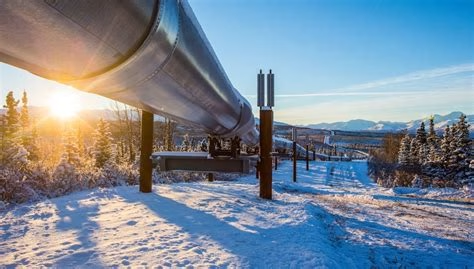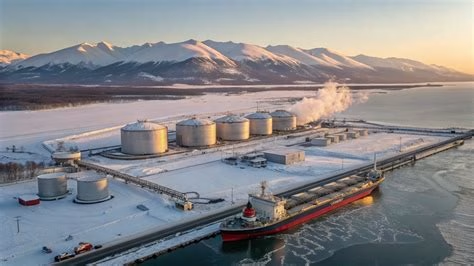Updated December 8, 2025 – POSCO International has joined Glenfarne’s Alaska LNG pipeline project as partner, delivering the project’s first firm commercial commitment and completing what developers are calling a ‘hat-trick’ of recent breakthrough deals. Under the agreement, POSCO will supply steel for the 807 mile pipeline, invest pre-FID capital, and take 1 mtpa of LNG under a 20-year heads-of-agreement. This is an important offtake signing that significantly strengthens the project’s commercial foundation. POSCO partnering up for the project also renews momentum for the $44 billion development after years of delay. The new agreement also adds the Korean company to a growing list of Asian buyers expressing interest in the LNG project. Together, they continue pushing the scheme closer to final investment decision. The strategic partnership also comes after three Japanese companies joined the Live Oak synthetic LNG project in Nebraska.

Tokyo Gas in Offtake Deal with Glenfarne’s $44 billion Alaska LNG Pipeline Project
Reported October 24, 2025 – Glenfarne, the majority owner of the Alaska LNG pipeline project, has announced a Letter of Intent (LOI) with Tokyo Gas for offtake of 1 million tonnes per annum (mtpa) of LNG from the US $44 billion export project. The Tokyo Gas agreement is the latest in a series of commercial breakthroughs for Glenfarne together with Japan’s JERA who inked a LNG offtake in September 2025.
Construction of the LNG pipeline will begin in late 2026, with commissioning expected in 2029.
Alaska LNG (AKLNG) Pipeline Project Factsheet
Developer: Glenfarne with 75 per cent ownership and AGDC with remaining 25 per cent.
Offtakes: Tokyo Gas (1 mtpa), JERA (1 mtpa), PTT (2 mtpa), POSCO (1 mtpa)
Target Export Capacity: 20 mtpa. Compare with Woodside’s Louisiana LNG project at 27.6 mtpa expansion target.
Pipeline: 807 miles, 42-inch diameter
Carbon Capture: 7 million tonnes CO2 annually
Target FID of Pipeline: Late 2025
Target FID of Export Infrastructure: 2026
Start of Construction: Expected by Late 2026
Target Commissioning: Mid-2029
Timeline of Key 2025 Events
October – Tokyo Gas LOI for 1 mtpa LNG signed.
September – POSCO-Glenfarne preliminary 1 mtpa and steel deal. JERA also signs LOI for 1 mtpa LNG supply.
June – PTT cooperation and 2 mtpa LNG agreement announced. Over US $115 billion in formal interest from more than 50 companies is also announced.
March – Glenfarne becomes lead developer of Alaska LNG with 75 per cent stake.
January – AGDC and Glenfarne announce development plans for US $44 billion Alaska LNG project.

Development of Alaska LNG Pipeline Project Through the Years
2021 to 2022
AGDC publishes greenhouse-gas assessment showing Alaska LNG could reduce CO2 emissions by 77 million tonnes per year compared with coal in Asia.
U.S. DOE releases Supplemental Environmental Impact Statement reinstating earlier permits.
AGDC submits carbon-capture and hydrogen proposals supported by state decarbonization goals.
2023
April – U.S. administration reaffirms support for Alaska LNG. Calls it strategic for energy security.
AGDC continues technical and pre-FID studies with early private partners.
2024
June – AGDC signs Gas Sales Precedent Agreement with Pantheon Resources for in-state gas supply.
November – Wood Mackenzie validates Alaska LNG Phase 1 economics.
December – AIDEA approves resolutions supporting the pipeline component.
2025
January – AGDC appoints Glenfarne Energy as lead developer with 75 per cent stake of US $44 billion project cost.
March – Glenfarne formally assumes management and ownership control.
May – Worley Group contracted for final engineering (FEED).
June – Glenfarne reports US $115 billion in partner interest. Also signs a deal with Thailand’s PTT.
September – Japan’s JERA signs agreement for 1 mtpa LNG over 20 years. South Korea’s POSCO also signs deal for 1 mtpa LNG and pipeline steel supply.
October – Glenfarne confirms FEED completion within 2025 and targeted FID for late 2025. The developer announces another offtake deal. This time with Japan’s Tokyo Gas for 1 mtpa from the Alaska LNG project, marking the fourth major Asian buyer engagement.
US DOI Approves Permits for Alaska LNG Pipeline Project
Reported August 14, 2021 – The US Department of Interior has announced decisions for the Alaska Liquified Natural Gas (LNG) Pipeline Project, approving the issuance of rights-of-way permits across federal lands managed by the Bureau of Land Management (BLM) and National Park Service (NPS). These decisions, which adopt the Federal Energy Regulatory Commission’s (FERC) environmental impact statement (EIS), establish the environmental protections for wetlands, wildlife, recreation access and other resources that will govern access for a liquified natural gas pipeline; a major step in the permit process for the project.
The Alaska Gasline Development Corporation is seeking permits to construct and operate the Alaska LNG pipeline project, which would transport natural gas for export to foreign markets and provide for in-state gas deliveries. Access across Federal lands is required for approximately 230 miles of the 807-mile pipeline.
These lands are mostly managed by the BLM, and most of the affected acreage is in the Dalton Highway/Trans-Alaska Pipeline corridor, which is managed primarily as a utility and transportation corridor. The project includes a gas treatment plant at Prudhoe Bay, a buried 42” diameter pipeline, and a liquefaction facility and export terminal in Nikiski, Alaska.
Also Read: Construction of Dangote oil refinery Africa’s largest nears completion
Supply to Denali National Park and Preserve
The project includes the potential to supply Denali National Park and Preserve and nearby communities with natural gas. According to Assistant Secretary for Fish and Wildlife and Parks Robert Wallace, careful environmental management will ensure park resources, including wildlife, wetlands, vegetation and noise/soundscapes, will be protected during and after construction.
The NPS is issuing a right-of-way for the approximately six-mile portion of pipeline within a non-wilderness area of the Denali National Park and Preserve (DNPP). The route selected through the park is near the existing transportation corridor (the Parks Highway and Alaska Railroad extend across this area of the park), which limits impacts to park viewsheds and overall acreage of wetlands, and reduces the need for additional roads and their associated impacts.
The Denali National Park Improvement Act of 2013, as amended by the John D. Dingell, Jr. Conservation, Management, and Recreation Act of 2019, authorized a right-of-way permit for the natural gas transmission pipeline in non-wilderness areas within Denali National Park. Per the Act, the NPS may only issue a right-of-way permit consistent with the laws and regulations governing these right-of-way permits in the national park system, and only if the right-of-way is the route through Denali Park with the least adverse environmental effects.

Leave a Reply